“On motion of Dean Wald, the Public Occasions Committee was instructed to arrange, if possible, for some form of entertainment to be given the students by the faculty before the Christmas holidays.” (Minutes of Regular Faculty Meeting, Dec. 7th, 1921)
Eighty-Five years ago this December, a long forgotten chapter in the history of Millikin traditions was born out of the above entry made in the minutes of a faculty meeting in 1921. For the next eleven years, a tradition blossomed into one of the most memorable annual events that students and Decatur residents alike looked forward to each December during the decade of the Twenties. This tradition should not in any way be confused with the current Vespers tradition which began independently of this tradition in 1959 and continues to this day. This exhibit tells the story of the rise, heights, and ultimate demise, of the early tradition of Christmas Vespers.
1921: The Tradition Begun
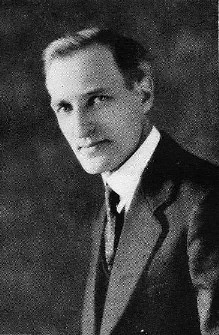
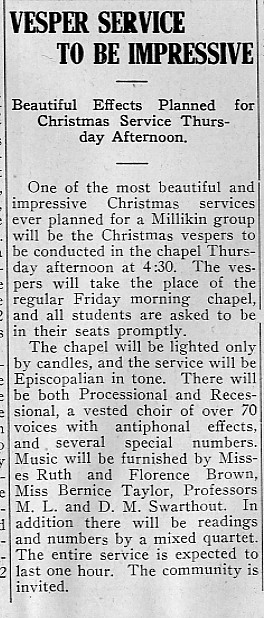
Above: Dean Arthur E. Wald
Left: Decaturian article
In December of 1921, Dean of the College, Arthur Wald's motion to provide "some form of entertainment" for the Christmas holidays at a faculty meeting led directly to the notice at right, which appeared in The Decaturian, the student newspaper, on December 15th, 1921.
The form of entertainment was to be an afternoon Christmas Vespers service in lieu of the regular Friday morning chapel services.
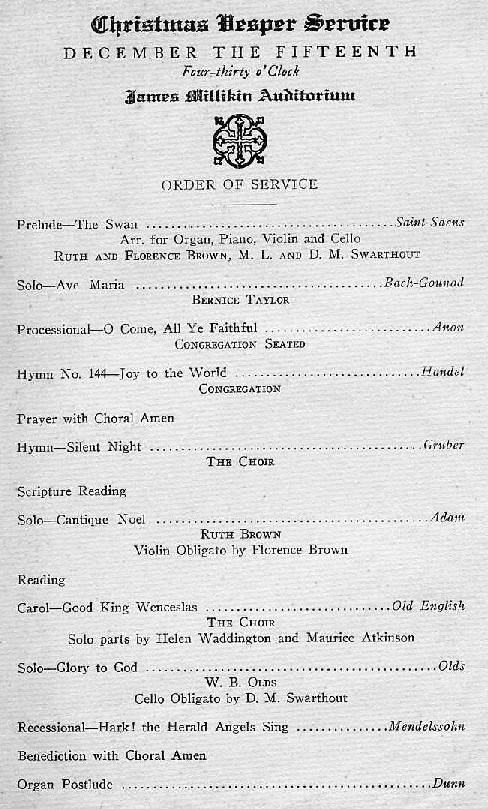
Above: Vespers Program
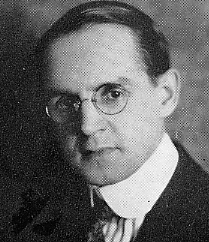
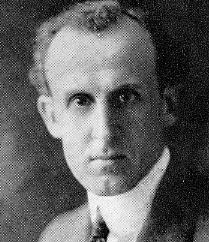
M.L. Swarthout D.M. Swarthout
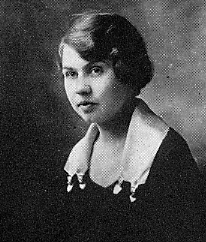
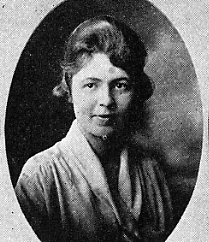
Ruth Brown Florence Brown

W.B. Olds

Review of the 1921 Christmas Vespers that appeared in The Decaturian on Jan 5th, 1922.
1922: The Tradition Expanded
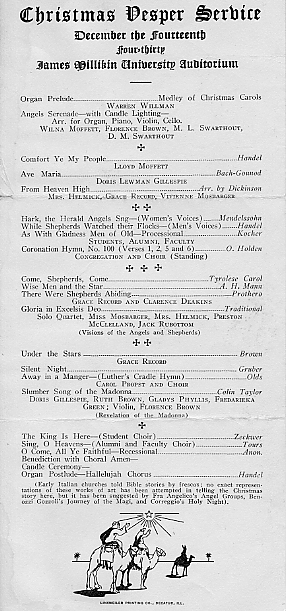
Left: 1922 Christmas Vespers Program
In 1922, one of the key elements of the early tradition Christmas Vespers was added, and that was the "living stills" or "Tableaux" that were presented on stage.
The note at the bottom of this program reads:
"Early Italian churches told Bible stories by frescos; no exact representations of those works of art has been attempted in telling the Christmas story here, but it has been suggested by Fra Angelico's Angel Groups, Benozzi Gozzoli's Journey of the Magi, and Correggio's Holy Night"
Below are the only two known images of these staged "Tableaux" from the early tradition of Christmas Vespers

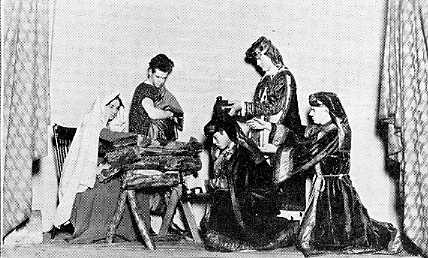
Here is how the program was described in The Decaturian when students returned to Millikin after the Christmas break
Christmas Vespers Very Impressive
(The Decaturian Jan 25, 1923 p.1,6)
"In the late afternoon of the Thursday before Christmas vacation, Dec. 14, an atmosphere of solemnity and hushed anticipation pervaded the crowded University auditorium. The tall white candles of the candelabra were lighted, revealing the stage embanked with evergreen. An organ medley of Christmas carols preceded the opening songs and their accompaniment of organ, piano, violin and ‘cello. With a coronet leading “As With Gladness Men of Old,” the grand processional of two hundred students, faculty, and alumni, clad in vestments of black cassocks and white cottas carrying lighted candles, filed slowly through the main floor entrance and down the aisles, breaking into six choirs, which took their places on the stage and in the balcony.
Two solos, “Under the Stars,” by Grace Record, and “Away in a Manger,” by Carol Propst, developed the theme of the nativity which reached its climax in the “Slumber Song of the Madonna” sung by Ruth Brown, Gladys Phyllis, Fredarieka Green, and Mrs. Doris Lewman Gillespie, with violin obligato by Miss Florence Brown. At its close a beautiful tableaux of the Holy Night was revealed: the central figure of the Madonna bending over the manger with Joseph in the background, and the richly robed wisemen kneeling and proffering their gifts of gold, frankinsense, and myrrh.
The balcony choir of faculty and alumnae under the direction of Mr. Swarthout, gave “Sing O Heavens” which was followed by the Recessional, “O Come, All Ye Faithful.” A benediction with a choral amen concluded the ceremony. Handel's “Hallelujah Chorus” was given as an organ postlude.
The chorals and solo numbers of Grace Record and Clarence Deakins after the processional, led to the dramatic “Gloria in Excelsis Deo” by a solo quarter of Miss Vivienne Mosbarger, Mrs. Louise Helmick, Preston McClelland, and Jack Rubottom, from the skylight of the auditorium and re-echoed in turn by the five choirs in the balcony and on the stage."
1923: The Tradition Solidified
By 1923, the tradition of a Christmas Vespers put on by the faculty had become firmly entrenched among the prominent annual events on the Millikin calendar. At a special meeting of the faculty that fall: “It was moved and voted that the Committee on Public Occasions be authorized to proceed with preparations for a Vesper Service like that of last year preceding the holiday vacation, and rely upon financial support, to the amount indicated, from the faculty, this to be raised by such assessment as might seem appropriate.”
The Millikin faculty were now firmly committed into presenting the students and community with this annual gift and would annually assess themselves to provide the finances necessary to put the Vespers together until the tradition ended after the 1931 Christmas Vespers.
Solemnity and Beauty Mark Christmas Vesper Service
Annual Affair to be Given This Afternoon at Four-Thirty in Auditorium – Episcopal Service and Lighting to Be Used
(Decaturian December 13, 1923 p.1)
"Solemnity will characterize the Christmas vesper service to be given this afternoon at 4:30 in the chapel. This annual gift of the faculty to the students and friends of the university has become a Millikin tradition with a definite significance for those who have ever attended the service [emphasis added].
Tall, white candles in stately candelabra will fittingly light the chapel. The service has been so arranged as to tell the Christmas story in a beautiful panorama of song and picture. The first episode will signify the prophecy of the coming Messiah. In the second episode, which might be called the “Expectation,” the processional of students, alumni, and faculty will enter, robed in black cassocks with white cottas, and each carrying a lighted taper.
Glorious and triumphant in the third episode, the “Fulfillment of the Prophecy,” antiphonal choirs will echo and re-echo the glad tidings of the Nativity.
Every person in the usually filled chapel will be a participant this afternoon, if not actively, at least, in spirit for it is not to be a performance, but a service, impressive and devotional, inspired by true emotion for the meaning of Christmas."
Vespers Attract Large Audience
Solemnity and Charm of Impressive Christmas Still Lingers at Millikin
(Decaturian January 10, 1924 p.1)
"The Christmas season with all its happiness, excitement, and solemnity, has passed and seems now far away, yet among the pleasing memories, one very definitely remains, that of the impressive Christmas vesper service in the chapel on Thursday, Dec. 13.
The candle light processional, beautiful song service, and remarkably well posed pictures of the Christmas story fittingly observed the spirit of the Christmas season.
The vesper service has become one of Millikin's dearest traditions as well as a service of great interest to townspeople who thronged the chapel from early in their eagerness to take part in vespers."
1925: The Tradition Reaches its Peak
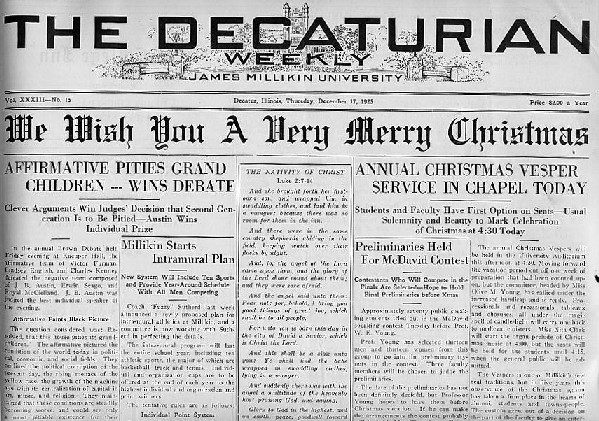
Decaturian front page Dec 17th, 1925 which contained the below two articles
Annual Christmas Vesper Service in Chapel Today
(The Decaturian Dec 17, 1925 p.1)
"The annual Christmas Vespers will be held in the University Auditorium this afternoon at 4:30. Moving forward the vacation period cut off one week of preparation that had been counted upon, but the committee, headed by Miss Olive M. Young, has rallied under the increased handicap and is ready. Processionals and recessionals, tableaux and choruses, all under the magic spell of candle-light will carry one back to medieval cloisters. Miss Nita Clark will start the organ prelude of Christmas music at 4:00, but the seats will be held for the students until 4:15, when the general public will be admitted.
The Vespers is one of Millikin's few real traditions, but in five years this observance of the Christmas season has taken a firm place in the hearts of alumni, students and towns-people. The custom grew out of a decision on the part of the faculty to give an entertainment for the students as a Christmas gift. In the process of development, the idea finally reached the stage where it is now found -- a quiet worshipful service of Christmas music and good-will that is appropriate in a Christian college…"
Christmas Vespers
(editorial from The Decaturian Dec 17, 1925 p.4)
"Millikin's annual Christmas Vespers will be given this afternoon. To the freshman it will be something new—something a little different probably from anything he has ever seen before. Curiosity may be the impelling factor in getting him to attend this year, but to those who have seen the Vespers before, there is a certain rather undefinable appeal, an expression of the finer things that draws them to the medieval service. It is a pageantry so vivid, a service so impressive, so different from anything else, so indicative of the deeper spirit of Millikin, that the memory of it will linger in the minds of the students long after other events of college days have gone into the dim recesses of the past.
But after all, it is not so much the form—the ritual—that is the underlying appeal—it is more the catching of the true spirit of Christmas, and the getting away from the hurry of life to observe the birth of Christ in a fitting manner."
1932: The Early Tradition's Untimely Demise
At a November 2nd, 1932 faculty council meeting: “It was moved and seconded that Christmas Vespers be discontinued for a period of one year.” – the motion was carried. The student response to this decision is best represented by the editorial below from The Decaturian.
Another Tradition Shattered?
(The Decaturian Dec. 2, 1932 p.2)
"There will be no Millikin Christmas vespers. The reasons, as rather unsatisfactorily explained to us, are somewhat as follows: (1) those formerly in charge of the service are no longer on the campus; (2) the choir will be too busy with the opera the week before to sing the hymns; (3) the Millikin vespers was the first of its kind in Decatur, and now that schools and churches have taken up the idea, our service is superfluous; (4) those in charge of the program this year have no particular interest in it. Thus, vespers, always beautiful in color and music, is denied us; a chapel, always dull and uneventful, is cheerfully granted us.
We suggest that the lack of interest on the part of this year's committee may be the potent factor in the decision. It may as well be admitted that the vespers each year has been the outstanding campus attempt to build from within an aesthetic Decatur. If this one group is not interested, they will find many among the students, faculty, and townspeople who are. It is not too late. Co-operation will not be lacking if it is looked for, and we do want vespers.
The Millikin chapter of the Y.W.C.A. attempted to restore the tradition in 1933 by putting on Vespers that Christmas. The Tableaux were replaced with pantomimes but no review of the event has been found. There was not a Christmas Vespers event again until the current tradition began in December of 1959. The current tradition is related to this earlier tradition in name only (it was not an attempt to reinstate the old tradition but was an entirely new tradition that continues to the present), there is no other connection between the two Christmas Vespers traditions."
This page created October 30, 2006 by Todd Rudat
Last Modified: November 7, 2006
Copyright: Millikin University Board of Trustees